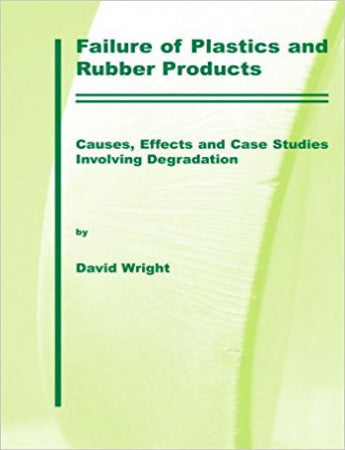Failures due to degradation may result from exposure to the weather or an aggressive operating environment. Alternatively, they may be caused by the introduction of an external agent unforeseen by the product designer. They may be rapid or very slow, and they may result from a combination of factors. In this book Dr. Wright describes the following mechanisms of polymer degradation, and then illustrates each failure mechanism with a number of case studies:
- Thermo-oxidation,
- Photo-oxidation,
- Degradation due to ionizing radiation,
- Chemical attack,
- Environmental stress cracking,
- Other miscellaneous effects, including treeing, electrochemical degradation and biodegradation.
the lessons that may be learned from it. Most of the failed products are familiar to us all, and his style is both readable and informative. Colored photographs are included where available.
The book will be essential reading for designers, engineers, product specifiers and forensic engineers. Materials suppliers and processors will also benefit from the pragmatic analysis and advice it contains. It will also be of value to all students of polymer science and technology, providing an essential insight into the practical application of plastics and rubbers and the potential problems. Finally, it will be of interest to a much broader readership, including anyone who ever wondered why things break, and it should become a standard reference work in all technical libraries.
This book was written with the support of the UK Department of Trade and Industry. It is intended to raise awareness of the causes and consequences of polymer product failures, in order to reduce the future
incidences of such failures, and their considerable costs to industry
1 Failure Analysis - A Personal Perspective
1.1 Introduction
1.2 Identification of strategic weaknesses
1.3 Identification of human and material weaknesses
1.4 Identification of product testing weaknesses
1.5 Priorities for future consideration
2 Thermo-oxidation
2.1 Introduction
2.2 The influence of polymer chemistry
2.3 The efficacy of stabilising additives
2.4 Metal catalysis
2.5 The influence of stress
2.6 The oxidising medium
2.7 Oxidation and stabilisation of polyvinyl chloride
2.8 Case studies
3 Photo-oxidation
3.1 Introduction
3.2 The severity of exposure
3.3 The influence of polymer chemistry
3.4 Stabilisation
3.5 Material and application examples
3.6 Case studies
4 Degradation Due to Ionising Radiation
4.1 Introduction
4.2 Degradation mechanisms
4.3 Radiation resistance of polymers
4.4 Performance of specific materials
4.5 Failure examples
5 Chemical Attack
5.1 Introduction
5.2 Solvation effects
5.3 Oxidation
5.4 Acid induced stress corrosion cracking
5.5 Hydrolysis
5.6 Case studies
6 Environmental Stress Cracking
6.1 Introduction
6.2 Crazing and cracking in air
6.3 Crazing and cracking in active fluids
6.4 Performance of specific materials
6.5 Case studies
7 Other Miscellaneous Effects
7.1 Electrical treeing and water treeing
7.2 Electrochemical degradation
7.3 Biodegradation
7.4 Diffusion, permeation, and migration
7.5 Physical ageing
7.6 Case studies
Abbreviations and Acronyms
Index




